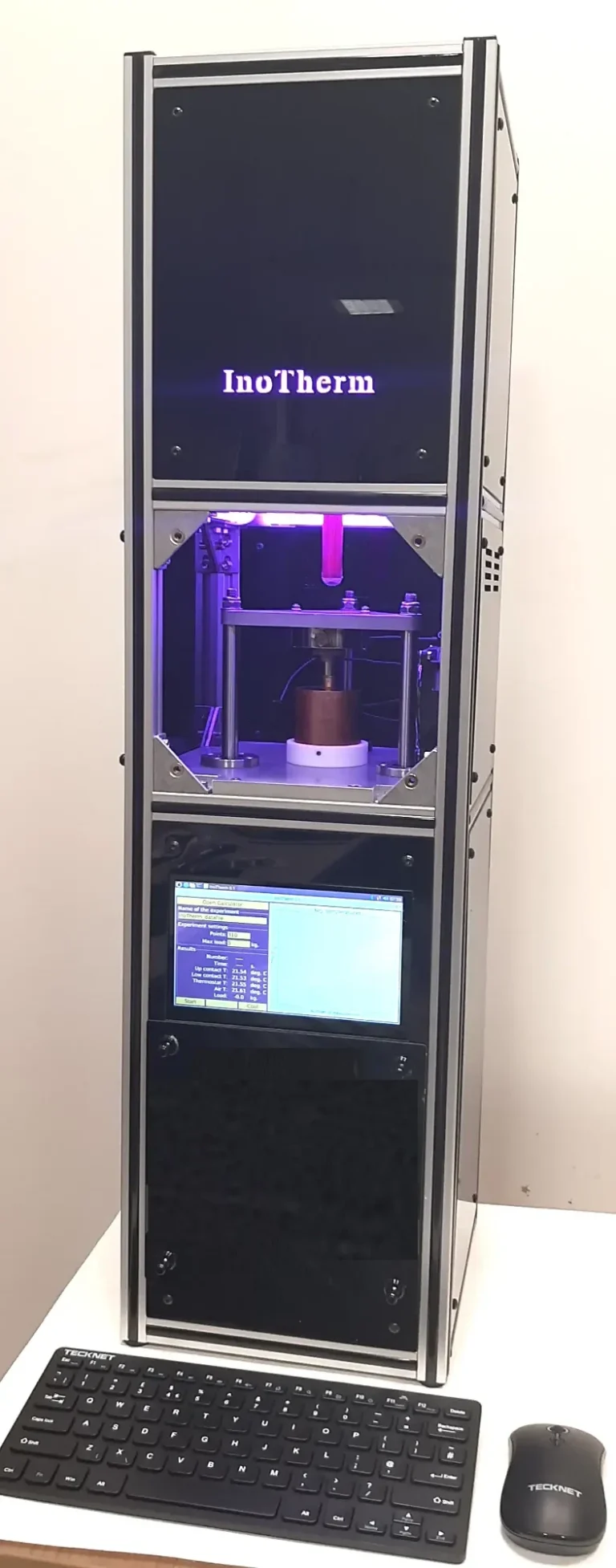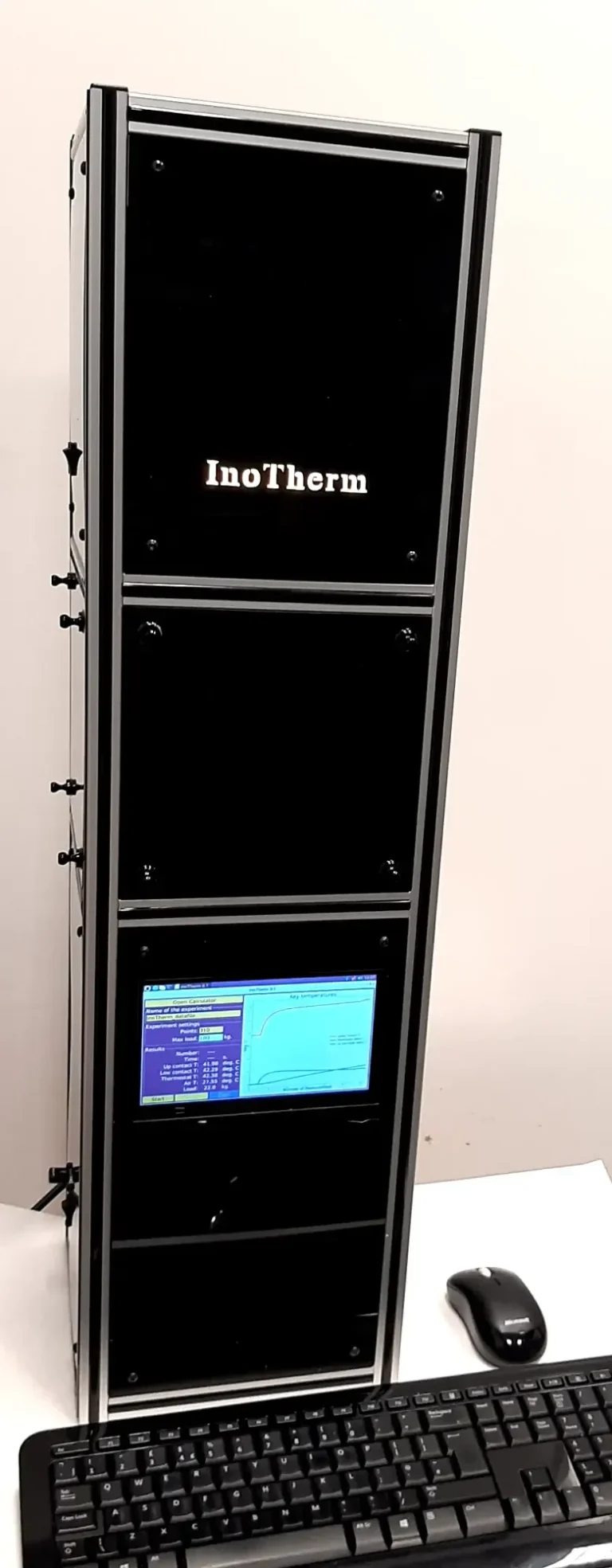Thermal Conductivity & Thermoelectricity Analysis

InoTherm ®
The thermal conductivity coefficient is directly measured
Accurate
errors not exceeding
3% at k = 0.05 ÷ 1 W/m∙K,
2% at k = 5 ÷ 150 W/m∙K,
4% at k = 200 ÷ 500 W/m∙K.
Versatile
- Measure the Thermal Conductivity Coefficient of solids, liquids, powders, and pastes with InoTherm
- A sample to measure is the size of a bean!
- Measure the Seebeck Coefficient and the Thermal Conductivity Coefficient simultaneously with InoTherm-S
Cost-efficient
- Small samples
Measured samples are discs with diameters from 8mm and heights from 0.5 mm or similar volumes of liquid or paste.
- Artless sample preparation
No polishing is required; the sample faces non-parallelism of up to 5ᵒ is allowed.
- Short measuring time
7-minute measuring process with an instant thermal conductivity and thermoelectricity calculation.
Digital system stability
The instrument has a self-contained electronic system and does not depend on ubiquitous hardware and software packages.

Thermal conductivity phenomenon
Thermal conductivity refers to the ability of materials to transfer heat (e.g., thermal energy) from a body with higher thermal energy (e.g., with higher temperature) to a body with lower thermal energy (e.g., with lower temperature). There are stationary and non-stationary thermal conductivity processes. The stationary process occurs when the temperature difference remains constant. The non-stationary process is observed when the temperature difference changes with time.
Quantitatively, a material's capability to transfer heat is characterized by the thermal conductivity coefficient (k), which is the amount of heat passing through the homogeneous sample of unit length and unit area if the temperature difference is 1 K. In the International System of Units (SI), the thermal conductivity coefficient is expressed as W/(m·K).
During the stationary thermal conductivity process, the energy flux density is proportional to the temperature difference (see the picture). There: Q is the energy transferred through conductor thickness h during time t via the conductor area A. The equation shows that the value of k can be obtained given the temperature difference and the amount of heat transferred via the sample with known geometry.
InoTherm® is a unique, new-generation device for quick, direct measurements of thermal conductivity coefficient. Initially designed for solids, it can also measure the thermal properties of gels, liquids, and powders.
The system measures the thermal energy that transfers from the heat source to the thermostat via the measured sample. The temperatures of the sample faces, the thermostat, and the surrounding air are precisely measured.
The raw data are presented on the screen during the measurement process and automatically collected into a data file. After data processing, the file also contains the thermal conductivity coefficient and the calculated error margins.
The instrument is factory-calibrated on standard samples and with all correction factors. It can be re-calibrated at the user site and by the user.


Why choose the InoTherm?
- Direct measurements: The heat transfer through your material is measured in the most natural conditions.
- Easy to use: 7 min to obtain the thermal conductivity, k, value.
- Data reliability and precision: The direct measurements have an error not exceeding 3% at k = 0.05 ÷ 1 W/m∙K, 2% at k = 5 ÷ 150 W/m∙K, and 4% at k = 200 ÷ 500 W/m∙K; the data acquired with InoTherm have been published in high rated materials science journals.
- Undemanding sample preparation requirements: The sample should be a cylinder with a diameter starting from 7 mm and a thickness between 0.5 and 10 mm. Those are the smallest samples for direct heat flow measurements in the World! Only rough polishing of the solid sample faces is needed; up to 5 degrees of sample face non-parallelism is acceptable. The sample volume is just 0.1 ÷ 0.8 cm3, which is important for expensive materials.
- Versatility: The thermal conductivity coefficients of solids, liquids, gels, and powders can be measured. The Seebeck Coefficient and the Thermal Conductivity can be measured simultaneously with the InoTherm-S machine.
- Digital system stability: The InoTherm is governed by a Raspberry Pi controller and thus does not depend on Windows updates.
The InoTherm application areas:
- Thermal protection systems
- Thermoelectric power
- Battery systems
- Thermal insulation
- Building materials
- Polymer composites
- Thermal conductive liquids
- Thermal interface materials
- Nanocomposites
- Green Energy
- Nuclear materials


Please contact us to learn more about InoTherm

We need your consent to load the translations
We use a third-party service to translate the website content that may collect data about your activity. Please review the details in the privacy policy and accept the service to view the translations.

